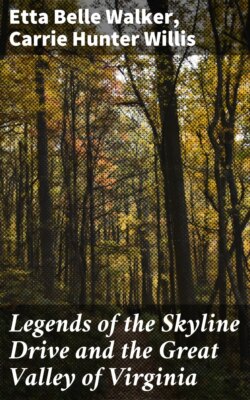Читать книгу Legends of the Skyline Drive and the Great Valley of Virginia - Etta Belle Walker - Страница 9
На сайте Литреса книга снята с продажи.
Quakers
ОглавлениеTable of Contents
Long ago, a shrewd trader from New York, John VanMeter, came into the Valley. He made friends with the Delawares and often went with them on their hunting trips. Once he even fought on their side against their enemies, the Catawbas. While on this visit South, he saw for the first time the fertile native grass, which grew "five or six feet high", in the Valley. When he returned to New York he told his sons about the rich country, far to the South, and advised them to secure some of it. One of them, Isaac, took his father's advice and came to Virginia in 1736-7 and with a tomahawk cut certain trees, thus making his original claim. This was called the "Tomakawk Right".
Isaac and his brother John secured a warrant from Governor Gooch for forty thousand acres of land. Later on they sold or transferred part of their grant to Joist Hite who was later called the "Old Baron". The latter was one of the hardiest pioneers and in 1734 was appointed by the Virginia Council to act as magistrate. This gave him authority to settle disputes, and to uphold the laws of Virginia as well as to punish all offenders.
Hite soon built a stone house on Opequon Creek and his sons and daughters grew to be splendid men and women. His sons-in-law, George Bowman, Jacob Chrisman and Paul Froman and their families had come with him from Pennsylvania. Robert McKay, Robert Green, William Duff, Peter Stevens and several other families helped each other select land, build homes and a fort.
We are told that the Indians had heard of the kindly relations which existed between the Indians and William Penn's colonists. We know he paid the Indians for their lands, and records show that many of the Germans, especially the Quakers, who settled on Apple Pie Ridge also bought lands from the Indians. These settlers were never disturbed by the Indians. However, when it came to the lands which we now call the Great Valley of Virginia, the Indians were agreed among themselves that no one tribe was to possess any of it. The lands were so fertile and so much game feasted there, that all should be at peace when in the Valley.
So when the first Quakers came we find these names recorded: the Neills, Walkers, Bransons, McKays, Hackneys, Beesoms, Luptons, Barretts, Dillons and Fawcetts.
Another Quaker, Ross, obtained a warrant for surveying lands and his lines were run along the Opequon, north of Winchester, and up to Apple Pie Ridge. Soon many other Quakers from Pennsylvania were moving into the Valley to settle on Ross's surveys. By 1738 these deeply religious people had built homes and were holding monthly meetings to worship God. They had tiny settlements up and down the Valley. They cultivated their farms, took little interest in politics, cared very little for worldly intercourse and made excellent neighbors. Their manners and dress were plain, their furniture only what was necessary, their homes were crude, but their barns were large and their cattle were well protected.
They refused to pay taxes during the Revolutionary War or to bear arms. Then their neighbors began to ridicule them, calling them cowards, and were no longer friendly. Officers came and seized their crops or property and sold them to raise funds with which to carry on the War against England. The Legislature enacted a law whereby a Quaker either had to fight or pay a substitute to fight for him. Their personal property was put under the hammer and soon they were reduced to poverty. One incident will give us a picture of those far-off days. James Gotharp lived with his neighbors on Apple Pie Ridge. One day during the Revolutionary War officers came, demanding that he should march away with them to join the militia; he refused. The men forced him to come along and later he was made a guard. He was placed beside a baggage wagon and told to let no man go into the wagon who did not have a written order from the commanding officer. Along came an officer who started to climb into the vehicle. James called to him and demanded to see his order of authority. The officer cursed him and stepped up to climb in. James caught him by his legs and pulled his feet off the step. This caused the officer to fall, striking his face against the wagon, bruising his nose and mouth severely.
The dress of the Quakers is still picturesque and many are to be seen in certain sections of the Valley. They wear a broad brimmed hat, a long frock coat, generally black. The women wear full skirts, down to their ankles, black hose, plain black shoes, with round toes. Their bodices, usually black or gray in color, are severely cut, with long plain sleeves, with a high neck, relieved by a white collar. They usually wear a small cap, made of the same material as their dress.
